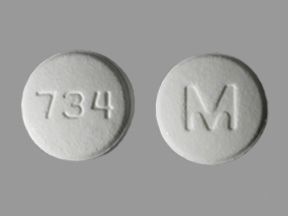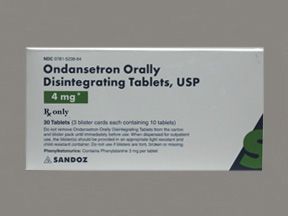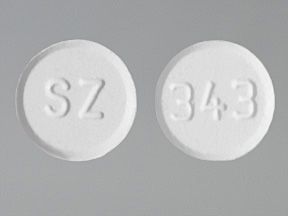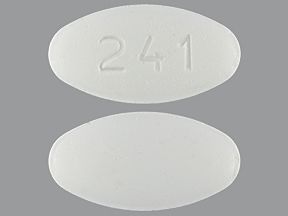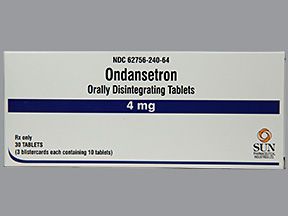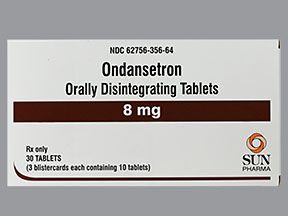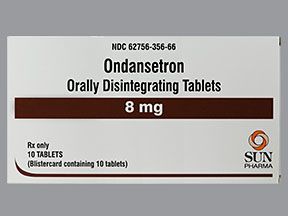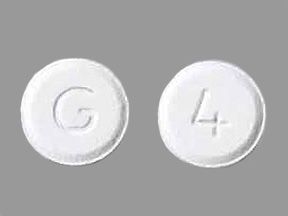Ondansetron is a generic prescription drug. It’s FDA-approved to help prevent nausea and vomiting in certain situations.
Specifically, the drug is prescribed for:
- adults receiving chemotherapy for cancer, when the chemotherapy is very likely to cause nausea and vomiting
- adults and children ages 4 years and older receiving chemotherapy for cancer, when the chemotherapy is somewhat likely to cause nausea and vomiting
- adults receiving radiation therapy, when the radiation treats the whole body or only the abdomen
- adults having surgery
For more information, see the “Ondansetron oral tablets uses” section below.
Drug details
Ondansetron belongs to a class of drugs called serotonin antagonists. It comes in the following forms and strengths:
- oral tablet: 4 milligrams (mg), 8 mg, and 24 mg
- orally disintegrating tablet (ODT): 4 mg and 8 mg
Ondansetron also comes in an oral solution and forms that are injectable. However, this article does not cover them. Your doctor can tell you more about these forms.
Brand-name versions
Ondansetron oral tablets are not currently available in any brand-name forms. Zofran and Zofran ODT were the brand-name forms of ondansetron oral tablets, but they’re no longer available.
The oral solution form of ondansetron has a brand-name version. For information about this version, talk with your doctor or pharmacist.
Ondansetron is a generic drug. A generic drug is an exact copy of the active drug in a brand-name medication. Zofran and Zofran ODT are the brand-name medications that ondansetron oral tablet is based on. However, Zofran and Zofran ODT are no longer available.
A generic is considered to be as safe and effective as the original drug. Generics tend to cost less than brand-name drugs.
To learn more about how generics compare with brand-name drugs, see this article.
Commonly recommended dosages for ondansetron in adults are described below. For information about the drug’s dosage in children, see “Ondansetron oral tablets pediatric dosage” below.
The ondansetron dosage your doctor prescribes will depend on several factors. These include:
- the reason you’re taking ondansetron
- other medical conditions you may have, such as liver problems
The following information describes dosages that are commonly used or recommended. However, be sure to take the dosage your doctor prescribes for you. Your doctor will determine the best dosage to fit your needs.
The maximum dose of ondansetron for all of its uses is 24 milligrams (mg) daily.
Adult dosage for chemotherapy that is very likely to cause nausea and vomiting
Here’s ondansetron dosage information in adults for chemotherapy that’s very likely to cause nausea and vomiting.
| Ondansetron for chemotherapy that is very likely to cause nausea and vomiting | |
| Forms | • oral tablet • orally disintegrating tablet (ODT) |
| Strengths | • oral tablet: 4 mg, 8 mg, and 24 mg • ODT: 4 mg and 8 mg |
| Dose | • 24 mg |
| How often | • one dose 30 minutes before a chemotherapy session |
| Administered by | • self |
Adult dosage for chemotherapy that is somewhat likely to cause nausea and vomiting
Here’s ondansetron dosage information in adults for chemotherapy that’s somewhat likely to cause nausea and vomiting.
| Ondansetron for chemotherapy that is somewhat likely to cause nausea and vomiting | |
| Forms | • oral tablet • orally disintegrating tablet (ODT) |
| Strengths | • oral tablet: 4 milligrams (mg), 8 mg, and 24 mg • ODT: 4 mg and 8 mg |
| Dose | • 8 mg per dose |
| How often | • one dose 30 minutes before a chemotherapy session followed by a second dose 8 hours later, then one dose twice daily for up to 2 days after the session |
| Administered by | • self |
Adult dosage for prevention of nausea and vomiting caused by radiation therapy
Here’s ondansetron dosage information in adults for prevention of nausea and vomiting caused by radiation therapy.
| Ondansetron for prevention of nausea and vomiting caused by radiation therapy | |
| Forms | • oral tablet • orally disintegrating tablet (ODT) |
| Strengths | • oral tablet: 4 milligrams (mg), 8 mg, and 24 mg • ODT: 4 mg and 8 mg |
| Dose | 8 mg per dose |
| How often | • for radiation therapy that treats the whole body: one dose 1 to 2 hours before each session • for a single session of radiation therapy that treats only the abdomen: one dose 1 to 2 hours before a radiation therapy session followed by one dose three times daily for up to 2 days after the session • for multiple sessions of radiation therapy that treat only the abdomen: one dose 1 to 2 hours before a radiation therapy session followed by one dose three times daily on each day a session is given |
| Administered by | • self |
Adult dosage for prevention of nausea and vomiting after surgery
Here’s ondansetron dosage information in adults for prevention of nausea and vomiting after surgery.
| Ondansetron for prevention of nausea and vomiting after surgery | |
| Forms | • oral tablet • orally disintegrating tablet (ODT) |
| Strengths | • oral tablet: 4 milligrams (mg), 8 mg, and 24 mg • ODT: 4 mg and 8 mg |
| Dose | • 16 mg |
| How often | • one dose 1 hour before anesthesia is given for the surgery |
| Administered by | • self |
What if I miss a dose?
Ondansetron is typically taken short-term to help prevent nausea and vomiting in certain situations. If you miss a dose of the drug, talk with your doctor. They’ll recommend whether you should take the missed dose or skip it.
To help make sure that you don’t miss a dose, try using a medication reminder. This can include setting an alarm or using a timer. You could also download a reminder app on your phone.
Will I need to use this drug long term?
Ondansetron is typically used as a short-term treatment. Your doctor can advise how long to take ondansetron for your specific condition.
Commonly recommended pediatric (children) dosages for ondansetron are described below. For information about the drug’s dosage in adults, see “Ondansetron oral tablets adult dosage” above.
The ondansetron dosage your child’s doctor prescribes will depend on several factors. These include:
- the reason your child is taking ondansetron
- your child’s age
- other medical conditions your child may have, such as liver problems
The following information describes dosages that are commonly used or recommended. However, be sure to give your child the dosage their doctor prescribes. Your child’s doctor will determine the best dosage to fit the child’s needs.
The maximum dose of ondansetron is 24 mg daily.
Children dosage for chemotherapy that is somewhat likely to cause nausea and vomiting
Here’s ondansetron dosage information in children for chemotherapy that’s somewhat likely to cause nausea and vomiting.
| Ondansetron for chemotherapy that is somewhat likely to cause nausea and vomiting | |
| Forms | • oral tablet • orally disintegrating tablet (ODT) |
| Strengths | • oral tablet: 4 mg, 8 mg, and 24 mg • ODT: 4 mg and 8 mg |
| Dose | • for children ages 4 to 11 years: 4 mg per dose • for children ages 12 to 17 years: 8 mg per dose |
| How often | • for children ages 4 to 11 years: one dose 30 minutes before a chemotherapy session followed by a second dose 4 hours later and a third dose 4 hours after the second dose, then one dose three times daily for up to 2 days after the session • for children ages 12 to 17 years: one dose 30 minutes before a chemotherapy session followed by a second dose 8 hours later, then one dose twice daily for up to 2 days after the session |
| Administered by | • self |
What if my child misses a dose?
Ondansetron is typically taken short-term to help prevent nausea and vomiting in certain situations. If your child misses a dose of the drug, talk with the child’s doctor. They’ll recommend whether the child should take the missed dose or skip it.
To help make sure that your child doesn’t miss a dose, try using a medication reminder. This can include setting an alarm or using a timer. You could also download a reminder app on your phone.
Will my child need to use this drug long term?
Ondansetron is typically used as a short-term treatment. Your child’s doctor can advise how long the child should take ondansetron for their specific condition.
Here are answers to some frequently asked questions about ondansetron.
Do the different strengths of ondansetron, such as 4-mg or 8-mg, cause certain side effects?
Probably not.
Ondansetron comes in the following forms and strengths:
- oral tablet: 4 milligrams (mg), 8 mg, and 24 mg
- orally disintegrating tablet (ODT): 4 mg and 8 mg
In general, the side effects of ondansetron are expected to be the same regardless of the strength you take. However, clinical trials of ondansetron oral tablet and ondansetron ODT did not provide side effects specific to each strength the drug comes in.
To learn more about what to expect with the strength of ondansetron you’re prescribed, talk with your doctor or pharmacist.
Is ondansetron used for nausea and vomiting in dogs?
Yes, a veterinarian may recommend ondansetron for nausea and vomiting in dogs.
Keep in mind that you should not give your dog medication that you’ve been prescribed by your doctor. You should only give ondansetron to a dog if it’s been prescribed by their veterinarian.
To learn more, talk with your dog’s veterinarian.
Can ondansetron be used for vertigo or motion sickness?
Ondansetron is not approved to treat vertigo (a feeling of dizziness or spinning) or motion sickness.
However, the drug may be used off-label for these conditions. Off-label drug use is when a drug the Food and Drug Administration (FDA) has approved is prescribed for a purpose other than what it’s approved for.
If you have vertigo or motion sickness, talk with your doctor. They can recommend the right treatment for your condition.
Is ondansetron a narcotic?
No, ondansetron is not a narcotic. (Narcotic is a term used to describe opioids, which is a class of drugs used to treat pain.) Instead, ondansetron belongs to a class of drugs called serotonin antagonists.
If you have other questions about ondansetron or narcotics, talk with your doctor or pharmacist.
How does ondansetron compare with other drugs used for nausea, such as granisetron?
Ondansetron belongs to a class of drugs called serotonin antagonists. It’s used to help prevent nausea and vomiting caused by certain situations, including chemotherapy, radiation therapy, and surgery.
Other serotonin antagonists are also used for similar purposes. These include granisetron (Sancuso, Sustol) and dolasetron (Anzemet).
Ondansetron, granisetron, and dolasetron come as oral tablets. Granisetron also comes in forms that are injected and applied to the skin.
Below are examples of other medications that may be used for nausea:
- dexamethasone (Hemady)
- prochlorperazine
- promethazine
- scopolamine (Transderm Scop)
Your doctor or pharmacist can tell you more about how ondansetron compares with other drugs used for nausea.
Can ondansetron be taken with acetaminophen (Tylenol)?
Yes, ondansetron can be taken with acetaminophen (Tylenol). There isn’t a known safety issue with taking these drugs together.
Tylenol is an over-the-counter pain reliever. If you’re in need of treatment options for pain, talk with your doctor or pharmacist. They’ll advise you on whether Tylenol can be used for your specific situation. And your doctor or pharmacist can make sure Tylenol doesn’t interact with any other medications you’re taking.
Ondansetron can cause mild or serious side effects (also known as adverse effects). The following lists contain some of the key side effects that may occur while taking ondansetron. These lists do not include all possible side effects.
In addition, side effects might differ slightly depending on the reason you’re taking ondansetron. For example, the side effects of ondansetron when it’s used to prevent nausea and vomiting from chemotherapy may differ from when the drug is used for radiation therapy or surgery.
For more information about the possible side effects of ondansetron, talk with your doctor or pharmacist. They can give you tips on how to manage any side effects that may be concerning or bothersome.
Note: The Food and Drug Administration (FDA) tracks side effects of drugs it has approved. If you’d like to notify the FDA about a side effect you’ve had with ondansetron, you can do so through MedWatch.
Mild side effects
Below is a partial list of mild side effects of ondansetron. To learn about other mild side effects, talk with your doctor or pharmacist, or view the prescribing information for ondansetron oral tablet and ondansetron ODT.
Mild side effects of ondansetron can include:
- constipation
- diarrhea
- dizziness
- fever
- headache
- itching
- fatigue
- malaise (feeling unwell)
- skin rash
- mild allergic reaction*
Most of these side effects may go away within a few days to a couple of weeks. However, if they become more severe or don’t go away, talk with your doctor or pharmacist.
* For more information about allergic reaction and ondansetron, see “Allergic reaction” below.
Serious side effects
Serious side effects from ondansetron aren’t common, but they can occur. Call your doctor right away if you have serious side effects. Call 911 or your local emergency number if your symptoms feel life threatening or if you think you’re having a medical emergency.
Serious side effects can include:
- agitation or anxiety
- extrapyramidal symptoms (a type of movement disorder)
- high levels of liver enzymes (a type of protein), which could be a sign of liver damage
- myocardial ischemia (reduced flow of blood and oxygen to the heart), which may lead to hypoxia (reduced flow of oxygen to the body’s cells)
- urinary retention (inability to completely empty your bladder)
- QT prolongation (a type of abnormal heart rhythm)
- serotonin syndrome (a condition caused by high levels of a brain chemical called serotonin)
- severe allergic reaction*
* For details about allergic reaction and ondansetron, see “Allergic reaction” below.
ALLERGIC REACTIONAs with most drugs, some people can have an allergic reaction after taking ondansetron. This was a rare side effect in clinical trials of ondansetron oral tablet and ondansetron ODT.
Symptoms of a mild allergic reaction can include:
A more severe allergic reaction is rare but possible. Symptoms of a severe allergic reaction can include:
- swelling under your skin, typically in your eyelids, lips, hands, or feet
- swelling of your tongue, mouth, or throat
- trouble breathing
Call your doctor right away if you have an allergic reaction to ondansetron, as the reaction could become severe. Call 911 or your local emergency number if your symptoms feel life threatening or if you think you’re having a medical emergency.
The Food and Drug Administration (FDA) approves prescription drugs such as ondansetron to treat certain conditions. ondansetron form may also be used off-label for other conditions. Off-label drug use is when an FDA-approved drug is prescribed for a purpose other than what it’s approved for.
Ondansetron is FDA-approved to help prevent nausea and vomiting in certain situations. Below is information on specific uses for ondansetron.
Ondansetron for chemotherapy that is very likely to cause nausea and vomiting
Ondansetron is FDA-approved for use in adults receiving chemotherapy that’s very likely to cause nausea and vomiting.
Chemotherapy that is very likely to cause nausea and vomiting explained
Chemotherapy is a treatment used for cancer. Nausea and vomiting are typical side effects of this treatment. However, certain chemotherapy drugs are more likely than others to cause nausea and vomiting.
Below are examples of chemotherapy drugs that are very likely to cause nausea and vomiting:
- cisplatin
- carmustine (BiCNU)
- dacarbazine
- mechlorethamine (Valchlor)
- streptozocin (Zanosar)
Taking ondansetron can help reduce the risk of nausea and vomiting as a side effect of chemotherapy.
If you’re using chemotherapy and have questions about the likelihood of nausea and vomiting with your specific treatment, talk with your doctor.
Ondansetron for chemotherapy that is somewhat likely to cause nausea and vomiting
Ondansetron is FDA-approved for use with chemotherapy that’s somewhat likely to cause nausea and vomiting. It’s approved for this use in adults and children ages 4 years and older.
Chemotherapy that is somewhat likely to cause nausea and vomiting explained
Chemotherapy is a treatment used for cancer. This treatment commonly causes nausea and vomiting. However, certain chemotherapy drugs are more likely than others to cause these side effects.
Below are examples of chemotherapy drugs that are somewhat likely to cause nausea and vomiting:
- carboplatin
- cytarabine
- doxorubicin (Doxil)
- irinotecan (Camptosar, Onivyde)
- oxaliplatin (Eloxatin)
Taking ondansetron can help reduce the risk of nausea and vomiting as a side effect of chemotherapy.
If you have questions about chemotherapy and its likelihood of nausea and vomiting, talk with your doctor.
Ondansetron for prevention of nausea and vomiting caused by radiation therapy
Ondansetron is FDA-approved for use in adults receiving radiation therapy. Specifically, it’s used to help prevent nausea and vomiting from radiation therapy that treats the whole body, or that only treats the abdomen.
Nausea and vomiting after radiation therapy explained
Radiation therapy is a treatment used for cancer. It works by using radiation to shrink or kill cancer cells.
Your risk of nausea and vomiting with radiation therapy depends on the part of your body being treated. The risk is highest when the abdomen is treated with radiation. However, nausea and vomiting are also risks of total body radiation.
Taking ondansetron can help reduce the risk of nausea and vomiting as a side effect of radiation.
If you have questions about nausea and vomiting with radiation therapy, talk with your doctor.
Ondansetron for prevention of nausea and vomiting after surgery
Ondansetron is FDA-approved to help prevent nausea and vomiting in adults having surgery.
Nausea and vomiting after surgery explained
Certain surgeries may require anesthesia, which is a medication that helps prevent pain during and after surgery. Nausea and vomiting are common side effects of anesthesia. These effects may occur even after the surgery is complete and the anesthesia has worn off.
Taking ondansetron can help reduce the risk of nausea and vomiting as a side effect of anesthesia used for surgery.
If you have questions about the risk of nausea and vomiting after surgery, talk with your doctor.
Ondansetron and children
Ondansetron is approved to help prevent nausea and vomiting in certain children. Specifically, the drug is used for children ages 4 years and older receiving chemotherapy that’s somewhat likely to cause nausea and vomiting.
To learn more, see “Ondansetron for chemotherapy that is somewhat likely to cause nausea and vomiting” above.
Keep reading to learn about ondansetron’s safety during pregnancy and while breastfeeding.
Ondansetron and pregnancy
It’s not known for certain whether ondansetron is safe to take while pregnant. Reports* of the drug’s use in pregnancy have not consistently shown the drug to be safe for use during this time.
If you’re pregnant or planning to become pregnant while taking ondansetron, talk with your doctor. They’ll discuss the risks and benefits of ondansetron treatment with you.
* For more details about ondansetron and pregnancy, see prescribing information for ondansetron oral tablet and ondansetron ODT.
Ondansetron and breastfeeding
It isn’t known whether it’s safe to breastfeed while taking ondansetron.
Animal trials* have shown the drug passes into animal milk. However, animal trials do not always predict what will happen in humans. It’s unknown if ondansetron may also pass into human breastmilk or cause side effects in a breastfed child.
If you’re breastfeeding or planning to breastfeed, talk with your doctor before taking ondansetron.
* For more details about ondansetron and breastfeeding, see prescribing information for ondansetron oral tablet and ondansetron ODT.
Ondansetron and birth control
It’s not known if ondansetron is safe to take during pregnancy. If you’re sexually active and you or your partner can become pregnant, talk with your doctor about your birth control needs while you’re using ondansetron.
For more information about taking ondansetron during pregnancy, see the “Ondansetron and pregnancy” above.
Ondansetron can interact with several other medications. However, it’s not known to interact with supplements or foods.
Different interactions can cause different effects. For instance, some interactions can interfere with how well a drug works. Other interactions can increase side effects or make them more severe. Drug-condition interactions can also cause certain effects. For information about these interactions, see the “Ondansetron oral tablets precautions” section below.
Ondansetron and other medications
Before taking ondansetron, talk with your doctor and pharmacist. Tell them about all prescription, over-the-counter, and other drugs you take. Also tell them about any vitamins, herbs, and supplements you use. Sharing this information can help you avoid potential interactions.
Below is a table of medications that can interact with ondansetron. This table does not contain all drugs that may interact with ondansetron.
| Medication type or medication name | Medication examples |
| selective serotonin reuptake inhibitors (SSRIs) | • sertraline (Zoloft) • citalopram (Celexa) • escitalopram (Lexapro) • fluoxetine (Prozac) |
| serotonin-norepinephrine reuptake inhibitors (SNRIs) | • venlafaxine (Effexor XR) • desvenlafaxine (Pristiq) • duloxetine (Cymbalta, Drizalma Sprinkle) • milnacipran (Savella) |
| monoamine oxidase inhibitors (MAOIs) | • selegiline (Emsam) • isocarboxazid (Marplan) • methylene blue (Provayblue) • linezolid (Zyvox) |
| triptans | • eletriptan (Relpax) • rizatriptan (Maxalt and Maxalt-MLT) • sumatriptan (Imitrex, Tosymra) • zolmitriptan (Zomig and Zomig-ZMT) |
| antipsychotics | • quetiapine (Seroquel, Seroquel XR) • olanzapine (Zyprexa) • risperidone (Risperdal) • ziprasidone (Geodon) |
| certain antibiotics | • azithromycin (Zithromax) • erythromycin (Eryc, Ery-Tab, others) • levofloxacin • ciprofloxacin (Cipro) • rifampin (Rifadin, Rimactane) |
| certain opioids | • tramadol (Conzip, Qdolo) • fentanyl (Actiq, Fentora, others) |
| certain seizure drugs | • carbamazepine (Carbatrol, Tegretol, others) • phenytoin (Dilantin, Phenytek) |
| apomorphine (Apokyn, Kynmobi) | — |
| mirtazapine (Remeron) | — |
| lithium (Lithobid) | — |
Your doctor or pharmacist can provide you with more information about the interactions between these medications and ondansetron. If you have questions about any drug interactions that may affect you, your doctor or pharmacist can address those as well.
You should take ondansetron according to the instructions your doctor gives you.
Ondansetron tablets come in two forms. One form is a tablet that you swallow. The other form is an orally disintegrating tablet (ODT), which dissolves when placed on your tongue. If needed, your doctor can show you how to use ondansetron ODT.
When to take
When you’ll take ondansetron depends on the reason you’re taking the drug.
For example, you may take only a single dose of ondansetron before chemotherapy, radiation, or surgery. Or you may take the drug two to three times daily. Your doctor will tell you how often you should take this medication for your specific situation.
To help make sure that you don’t miss a dose, try using a medication reminder. This can include setting an alarm or using a timer. You could also download a reminder app on your phone.
Accessible labels and containers
If your prescription label is hard to read, talk with your doctor or pharmacist. Some pharmacies offer labels that have large print, braille, or a code you scan with a smartphone to convert text to speech. If your local pharmacy doesn’t have these options, your doctor or pharmacist may be able to direct you to one that does.
If you have trouble opening medication bottles, ask your pharmacist if they can put ondansetron in an easy-open container. They also may be able to recommend tools that can make it simpler to open lids.
Taking ondansetron with food
You can take ondansetron with or without food.
Can ondansetron be crushed, split, or chewed?
The manufacturer of ondansetron oral tables does not state whether it’s safe to crush, split, or chew the tablets.
If you have trouble swallowing ondansetron oral tablet or ondansetron ODT, talk with your doctor or pharmacist.
How long does it take ondansetron to work?
Ondansetron typically starts working within 30 minutes after you take your dose.
There’s no known interaction between ondansetron and alcohol.
However, drinking alcohol may lead to nausea and vomiting. Ondansetron is used to help prevent nausea and vomiting related to chemotherapy, radiation therapy, and surgery. So, drinking alcohol with this drug could make it hard to tell if ondansetron is working for you.
If you drink alcohol, talk with your doctor before taking ondansetron. They can advise you on whether you should limit the amount of alcohol you consume while taking the drug.
As with all medications, the cost of ondansetron can vary. The actual price you’ll pay depends on your insurance plan, your location, and the pharmacy you use.
Keep in mind that you may be able to get a 90-day supply of ondansetron. If approved by your insurance company, getting a 90-day supply of the drug could reduce your number of trips to the pharmacy and help lower the cost. If you’re interested in this option, check with your doctor, pharmacist, or insurance company.
Before approving coverage for ondansetron, your insurance company may require you to get prior authorization. This means that your doctor and insurance company will need to communicate about your prescription before the insurance company will cover the drug. The insurance company will review the prior authorization request and decide if the drug will be covered.
If you’re not sure if you’ll need to get prior authorization for ondansetron, contact your insurance company.
Financial and insurance assistance
Financial assistance to help you pay for ondansetron may be available.
Medicine Assistance Tool and NeedyMeds are two websites offering resources that may help decrease the price you pay for ondansetron. They also offer tools to help you find low-cost healthcare, as well as educational resources. To learn more, visit their sites.
Mail-order pharmacies
Ondansetron may be available through a mail-order pharmacy. Using this service may help lower the drug’s cost and allow you to get your medication without leaving home.
If recommended by your doctor, you may be able to receive a 90-day supply of ondansetron, so there’s less concern about running out of the medication. If you’re interested in this option, check with your doctor, pharmacist, or insurance company. Some Medicare plans may help cover the cost of mail-order medications.
If you don’t have insurance, you can ask your doctor or pharmacist about online pharmacy options.
When you get ondansetron from the pharmacy, the pharmacist will add an expiration date to the label on the packaging. This date is typically 1 year from the date they dispensed the medication.
The expiration date helps guarantee that the medication is effective during this time. The
Storage
How long a medication remains good can depend on many factors, including how and where you store the medication.
You should store ondansetron oral tablets at room temperature of 68°F to 77°F (20°C to 25°C). You can temporarily store the tablets at a temperature of 59°F to 86°F (15°C to 30°C), such as while traveling. Be sure to store the drug in a tightly sealed container away from light. Also avoid storing this medication in areas where it could get damp or wet, such as bathrooms.
Disposal
If you no longer need to take ondansetron and have leftover medication, it’s important to dispose of it safely. This helps prevent others, including children and pets, from taking the drug by accident. It also helps keep the drug from harming the environment.
This article provides several useful tips on medication disposal. You can also ask your pharmacist for information about how to dispose of your medication.
This drug comes with several precautions. These are considered drug-condition interactions.
If any of the following medical conditions or other health factors pertain to you, be sure to talk with your doctor before taking ondansetron.
- if you’re pregnant or thinking about becoming pregnant
- if you’re breastfeeding or thinking about breastfeeding
- if you’ve had an allergic reaction to either drug or any of its ingredients
- if you have a bowel obstruction (blockage in your small or large intestine)
- if you have low blood levels of potassium or magnesium
- if you have a heart problem, such as heart failure or a slow and irregular heartbeat
- if you have a liver problem, such as liver failure
- if you have a genetic (inherited) condition called phenylketonuria (for ondansetron ODT only)
Note: For more information about the potential negative effects of ondansetron, see the “Ondansetron oral tablets side effects” section above.
Using more than the recommended dosage of ondansetron can lead to serious side effects. Do not use
more ondansetron than your doctor recommends. (For information on the recommended dosages of
ondansetron, see the “Ondansetron oral tablets adult dosage” and “Ondansetron oral tablets pediatric
dosage” sections above.
Overdose symptoms
Symptoms of an overdose can include:
- sudden vision loss
- severe constipation
- low blood pressure
- fainting
- heart block (a type of abnormal heart rhythm)
- serotonin syndrome (a condition caused by high levels of a brain chemical called serotonin)
What to do in case of overdose
If you think you’ve taken too much of this drug, call your doctor. You can also call the American Association of Poison Control Centers at 800-222-1222 or use its online tool. However, if your symptoms are severe, call 911 or your local emergency number, or go to the nearest emergency room right away.
Disclaimer: Medical News Today has made every effort to make certain that all information is factually correct, comprehensive, and up to date. However, this article should not be used as a substitute for the knowledge and expertise of a licensed healthcare professional. You should always consult your doctor or another healthcare professional before taking any medication. The drug information contained herein is subject to change and is not intended to cover all possible uses, directions, precautions, warnings, drug interactions, allergic reactions, or adverse effects. The absence of warnings or other information for a given drug does not indicate that the drug or drug combination is safe, effective, or appropriate for all patients or all specific uses.


